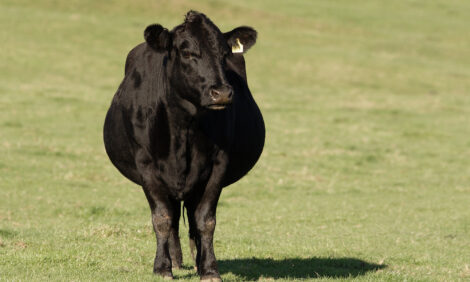



Spaying Heifers: What Is It Worth?
Jolene Kelzer, from the University of Minnesota Beef Team, looks at the benefits of spaying heifers in feed-lots and discusses whether it is cost effective.Heifers, depending on breed, age, weight and nutritional status, may reach puberty between nine and 16 months of age. Therefore there is potential that early spring-born heifers are already exhibiting estrus or will be soon.
Riding activity in the feedlot as a result of estrus increases risk of bodily injury and markedly reduces overall heifer intakes and gains. Additionally, one heifer exhibiting estrus can quickly disrupt the entire pen to lower overall feed efficiencies and shrink profit potential.
The most common method for estrus suppression in the feedlot is supplementing intact heifers with melengesterol acetate (MGA) at 0.5 mg per head per day.
This progesterone-like feed additive not only eliminates activity, disrupted intakes, and stress related to estrus, but also enhances and sustains endogenous estrogen production to increase gains and efficiencies in feedlot heifers.
Another procedure that effectively prevents estrus occurrence in feedlots is spaying heifers.
Spaying, or ovariectomising, female cattle is the surgical removal of both ovaries so heifers will not exhibit estrus.
Advantages associated with spaying heifers include maintaining feeder heifers in an open or neutered status, early detection of pregnant heifers accidently bred prior to feedlot entrance, prevention of pregnant heifers in the feedlot, elimination of feeding MGA or other estrus suppressing feed additives, and the ability to graze or feed heifers and steers together and within fence-line contact of herd sires.
Spaying is implemented more extensively in western US ranching states where management goals are focused on increasing production and performance of feedlot heifers.
With removal of the ovaries, spaying heifers eliminates the endogenous sources of gonadal steroids. The absence of these steroids, mainly estrogen and progesterone, may markedly reduce intake, daily gain, and feed efficiency in the feedlot.
Therefore, to recover lost performance, the natural anabolic effects of the ovaries must be replaced via implants in spayed heifers.
Some research suggests spayed heifers respond with greater gains and more efficient feed conversions when implanted with progesterone rather than testosterone.
In an experiment, implanted spayed heifers had a threefold improvement in average daily gain (0.66 vs. 0.20 lb/d increase) compared to intact, implanted heifers.
Spayed heifers implanted with progesterone tended to have heavier final bodyweights, heavier hot carcase weights, decreased backfat thickness, and improved marbling scores and yield grades.
In TB zones, where breeding cattle require a negative whole-herd TB test within 12 months in addition to the individual TB test within 60 days prior to shipment across state borders.
Since a spayed heifer is no longer considered a breeding animal, movement across state borders becomes easier, thus adding to the attractiveness of spaying.
In a recent study conducted by the University of Minnesota evaluating feedlot performance of spayed versus intact heifers during backgrounding and finishing phases, spayed heifers consumed less feed (14.17 vs. 14.46 lb/d) and had lower average daily gains (3.22 vs. 3.53 lb) than intact heifers during backgrounding.
Therefore, to reach a backgrounding end weight of 800 lb prior to feedlot entrance (assume a 500 lb initial weight), spayed heifers require an additional eight days on feed (93 vs. 85 days) compared to intact heifers. However, since spayed heifers are consuming less feed per day, this extra time on feed only requires an additional 113 lbs of feed per heifer.
At an assumed ration cost of $70 per ton, the 113 lbs of extra feed will cost the producer an additional $3.96, which is still less than supplementing MGA to an intact heifer (assume $0.05 per day for MGA multiplied by 85 days equals $4.25).
However, to account for spaying (approximately $18) and additional yardage expenses (assumed $0.50 per day), spayed heifers will cost another $22 over an intact heifer.
With all other expenses considered equal between spayed and intact heifers, a producer must be willing to spend an additional $21.71 (MGA cost taken into account) for each spayed heifer. Keep in mind that if TB testing costs approximately $25 per head, a $3.29 advantage to spaying heifers exists if the producer is located in the Modified Accredited Advanced TB zone and plans to market the heifer following backgrounding.
During the finishing phase of the experiment, it appeared spayed heifers were able to compensate for reduced performance during backgrounding and perform similarly to intact heifers with appropriate implanting.
Intact heifers had a slight advantage in feed efficiency over spayed heifers (5.74 vs. 5.95 lb feed per lb gain), but final bodyweights and hot carcase weights were similar among all heifers.
Additionally, there were no effects on carcase characteristics due to reproductive status. One thing to consider during the finishing phase was all heifers were implanted with either a moderate or aggressive terminal implant strategy.
The terminal implant likely allowed spayed heifers to overcome a slow start in backgrounding, which may be attributed to the combination of a low potency initial implant and lack of additional growth promotant, such as MGA.
That being said, producers in Minnesota are encouraged to consider spaying heifers, particularly if they plan to market heifers to out-of-state feedlots. Large cattle feeders will be attracted to and may pay premiums for heifers that will not come into estrus or develop pregnancies during the finishing phase.
Although spayed heifers may have reduced performance during the backgrounding phase, this difference in favor of intact heifers seems to be overcome by using a more aggressive initial implant or by the expenses of TB testing.
With appropriate implanting strategies and management, the initial expense of spaying heifers may be a worthwhile investment in the end.



